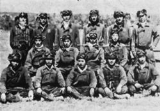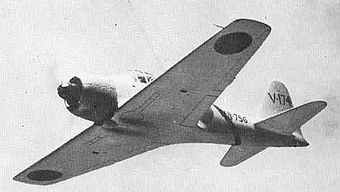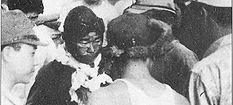
Tainan Air Group
Encyclopedia

Fighter aircraft
A fighter aircraft is a military aircraft designed primarily for air-to-air combat with other aircraft, as opposed to a bomber, which is designed primarily to attack ground targets...
and airbase garrison unit of the Imperial Japanese Navy
Imperial Japanese Navy
The Imperial Japanese Navy was the navy of the Empire of Japan from 1869 until 1947, when it was dissolved following Japan's constitutional renunciation of the use of force as a means of settling international disputes...
(IJN) during the Pacific campaign
Pacific War
The Pacific War, also sometimes called the Asia-Pacific War refers broadly to the parts of World War II that took place in the Pacific Ocean, its islands, and in East Asia, then called the Far East...
of World War II
World War II
World War II, or the Second World War , was a global conflict lasting from 1939 to 1945, involving most of the world's nations—including all of the great powers—eventually forming two opposing military alliances: the Allies and the Axis...
. The flying portion of the unit was heavily involved in many of the major campaigns and battles of the first year of the war. The exploits of the unit were widely publicized in the Japanese media at the time, at least in part because the unit spawned more aces
Flying ace
A flying ace or fighter ace is a military aviator credited with shooting down several enemy aircraft during aerial combat. The actual number of aerial victories required to officially qualify as an "ace" has varied, but is usually considered to be five or more...
than any other fighter unit in the IJN. The ace members of the unit included several of the IJN's top scorers and other aces such as Hiroyoshi Nishizawa
Hiroyoshi Nishizawa
Lieutenant Junior Grade was an ace of the Imperial Japanese Navy Air Service during World War II.It is possible that Nishizawa was the most successful Japanese fighter ace of the war; he personally claimed to have had 87 aerial victories at the time of his death...
, Saburō Sakai
Saburo Sakai
Sub-Lieutenant was a Japanese naval aviator and flying ace of the Imperial Japanese Navy during World War II. Sakai was the Imperial Navy's fourth-ranking ace and Japan's second leading fighter pilot to survive the war ....
, Junichi Sasai
Junichi Sasai
Lieutenant Commander was a Japanese naval aviator and fighter ace of the Imperial Japanese Navy during World War II. Lieutenant Sasai was killed leading his fighter squadron during an attack of Henderson Field during the Battle of Guadalcanal....
, Watari Handa, Masaaki Shimakawa
Masaaki Shimakawa
was a warrant officer and ace fighter pilot in the Imperial Japanese Navy during the Pacific theater of World War II. In aerial combat over the Pacific he was officially credited with destroying eight enemy aircraft with 12 or 13 assists....
, and Toshio Ōta
Toshio Ohta
was a World War II Japanese fighter ace. In early 1942, at the age of 22, he flew a Mitsubishi A6M Zero with the Lae based Tainan Air Group. There the young petty officer 1st class became one of the so-called 'clean up trio' of Japanese aces, along with his squadron mates Saburo Sakai and Hiroyoshi...
.
Philippines and Dutch East Indies
The unit was formed at TainanTainan
Tainan City is a city in southern Taiwan. It is the fifth largest after New Taipei, Kaohsiung, Taichung, and Taipei. It was formerly a provincial city, and in 2010, the provincial city merged with the adjacent Tainan County to form a single special municipality. Tainan faces the Taiwan Strait in...
, Taiwan
Taiwan
Taiwan , also known, especially in the past, as Formosa , is the largest island of the same-named island group of East Asia in the western Pacific Ocean and located off the southeastern coast of mainland China. The island forms over 99% of the current territory of the Republic of China following...
(then part of the Empire of Japan
Empire of Japan
The Empire of Japan is the name of the state of Japan that existed from the Meiji Restoration on 3 January 1868 to the enactment of the post-World War II Constitution of...
) on October 1, 1941 as part of the 23rd Air Flotilla. The unit's first commander was Lieutenant Hideki Shingō. Most of the unit's original pilots were veterans of aerial combat in the Second Sino-Japanese War
Second Sino-Japanese War
The Second Sino-Japanese War was a military conflict fought primarily between the Republic of China and the Empire of Japan. From 1937 to 1941, China fought Japan with some economic help from Germany , the Soviet Union and the United States...
. Just before the outbreak of war
Attack on Pearl Harbor
The attack on Pearl Harbor was a surprise military strike conducted by the Imperial Japanese Navy against the United States naval base at Pearl Harbor, Hawaii, on the morning of December 7, 1941...
with the Allied powers
Allies of World War II
The Allies of World War II were the countries that opposed the Axis powers during the Second World War . Former Axis states contributing to the Allied victory are not considered Allied states...
, the unit consisted of 45 A6M Zero
A6M Zero
The Mitsubishi A6M Zero was a long-range fighter aircraft operated by the Imperial Japanese Navy Air Service from 1940 to 1945. The A6M was designated as the , and also designated as the Mitsubishi A6M Rei-sen and Mitsubishi Navy 12-shi Carrier Fighter. The A6M was usually referred to by the...
and 12 Type 96
Mitsubishi A5M
The Mitsubishi A5M, Japanese Navy designation was "Type 96 carrier-based fighter" was a Japanese carrier-based fighter aircraft. It was the world's first monoplane shipboard fighter and the direct ancestor of the famous Mitsubishi A6M 'Zero'...
fighter aircraft.
On 8 December 1941 forty-four Tainan aircraft escorted IJN bombers in attacks on US aircraft at Iba
Iba Airfield
Iba Airfield is a former United States Army Air Forces airfield on Luzon in the Philippines. It was overrun by the Imperial Japanese Army during the Battle of the Philippines .-History:...
and Clark
Clark Air Base
Clark Air Base is a former United States Air Force base on Luzon Island in the Philippines, located 3 miles west of Angeles City, about 40 miles northwest of Metro Manila. Clark Air Base was an American military facility from 1903 to 1991...
airfields on Luzon
Luzon
Luzon is the largest island in the Philippines. It is located in the northernmost region of the archipelago, and is also the name for one of the three primary island groups in the country centered on the Island of Luzon...
in the Philippines, a distance of 500 miles each way. The attacks almost completely destroyed General Douglas MacArthur
Douglas MacArthur
General of the Army Douglas MacArthur was an American general and field marshal of the Philippine Army. He was a Chief of Staff of the United States Army during the 1930s and played a prominent role in the Pacific theater during World War II. He received the Medal of Honor for his service in the...
's air forces. On 10 December Tainan Zeros shot down the B-17 bomber piloted by Colin Kelly. Later that month, the unit redeployed to the Philippines and continued to support Japanese forces as they overran and destroyed the territory's American and Filipino defenses.
The Tainan Naval Air Group then moved to Tarakan Island
Tarakan Island
Tarakan is an island off the coast of East Kalimantan, Indonesia. It is a marshy island situated in the eastern Celebes Sea, off the northeastern coast of Borneo. The island occupies an area of .-Petroleum:...
, followed by moves to Balikpapan
Balikpapan
Balikpapan is a seaport city on the eastern coast of the island of Borneo, Indonesia, in the East Kalimantan province, a resource-rich region well known for its timber, mining, and petroleum export products. Two harbors, Semayang and Kariangau , and the Sepinggan International Airport are the main...
and Denpasar
Denpasar
Denpasar is the capital city of the province of Bali, Indonesia. It has a rapidly expanding population of 788,445 in 2010, up from 533,252 in the previous decade. It is located at .-History:...
, Bali
Bali
Bali is an Indonesian island located in the westernmost end of the Lesser Sunda Islands, lying between Java to the west and Lombok to the east...
to support the successful Japanese offensive into the Dutch East Indies
Dutch East Indies
The Dutch East Indies was a Dutch colony that became modern Indonesia following World War II. It was formed from the nationalised colonies of the Dutch East India Company, which came under the administration of the Netherlands government in 1800....
beginning in January 1942. The unit's fighters helped inflict heavy losses on defending Allied aircraft in January and February 1942.
New Guinea
With the end of the campaign in March, the unit was integrated into the 25th Air Flotilla25th Air Flotilla
The was a combat aviation unit of the Imperial Japanese Navy during the Pacific Campaign of World War II. The flotilla, mainly consisting of land-based bombers, fighters, and reconnaissance aircraft, reported to the IJN's 11th Air Fleet. As originally organized, the flotilla's core units were the...
and redeployed to recently-captured Rabaul
Rabaul
Rabaul is a township in East New Britain province, Papua New Guinea. The town was the provincial capital and most important settlement in the province until it was destroyed in 1994 by falling ash of a volcanic eruption. During the eruption, ash was sent thousands of metres into the air and the...
, New Britain
New Britain
New Britain, or Niu Briten, is the largest island in the Bismarck Archipelago of Papua New Guinea. It is separated from the island of New Guinea by the Dampier and Vitiaz Straits and from New Ireland by St. George's Channel...
and Lae
Lae
Lae, the capital of Morobe Province, is the second-largest city in Papua New Guinea. It is located at the start of the Highlands Highway which is the main land transport corridor from the Highlands region to the coast...
, Papua New Guinea
Papua New Guinea
Papua New Guinea , officially the Independent State of Papua New Guinea, is a country in Oceania, occupying the eastern half of the island of New Guinea and numerous offshore islands...
in April. As of 25 April 1942, due to operational and combat losses, the Tainan Air Group, now under the command of Captain Masahisa Saitō, counted 26 Zero and six Type 96 "Claude" fighters.
The unit initially concentrated its aircraft at Lae to support an air campaign against the Australian and American forces stationed at Port Moresby
Port Moresby
Port Moresby , or Pot Mosbi in Tok Pisin, is the capital and largest city of Papua New Guinea . It is located on the shores of the Gulf of Papua, on the southeastern coast of the island of New Guinea, which made it a prime objective for conquest by the Imperial Japanese forces during 1942–43...
. Between April and July, the Tainan Air Group flew 51 missions, totalling 602 sortie
Sortie
Sortie is a term for deployment or dispatch of one military unit, be it an aircraft, ship, or troops from a strongpoint. The sortie, whether by one or more aircraft or vessels, usually has a specific mission....
s. During this time, the unit claimed to have destroyed 300 enemy aircraft. The Tainan's losses were 20 aircraft. Replacement aircraft gave the unit a total of 24 Zeros by August 1942, flown by 55 pilots. Because of the surplus in aircrew, only the most experienced pilots were allowed to fly combat missions.
Guadalcanal
On August 7, United States Marines landed on Japanese-occupied GuadalcanalGuadalcanal
Guadalcanal is a tropical island in the South-Western Pacific. The largest island in the Solomons, it was discovered by the Spanish expedition of Alvaro de Mendaña in 1568...
, initiating the Guadalcanal Campaign
Guadalcanal campaign
The Guadalcanal Campaign, also known as the Battle of Guadalcanal and codenamed Operation Watchtower by Allied forces, was a military campaign fought between August 7, 1942 and February 9, 1943 on and around the island of Guadalcanal in the Pacific theatre of World War II...
. In response that same day, 18 Tainan fighters escorted bombers from Rabaul for an attack on the Allied invasion fleet, the longest fighter mission of the war (556 miles each way) to that date. The Tainan claimed to have destroyed 43 enemy aircraft over Guadalcanal on that mission while losing two fighters with their pilots themselves. The Americans actually lost 10 aircraft, including nine of 18 fighters
F4F Wildcat
The Grumman F4F Wildcat was an American carrier-based fighter aircraft that began service with both the United States Navy and the British Royal Navy in 1940...
present, plus one dive bomber
SBD Dauntless
The Douglas SBD Dauntless was a naval dive bomber made by Douglas during World War II. The SBD was the United States Navy's main dive bomber from mid-1940 until late 1943, when it was largely replaced by the SB2C Helldiver...
. The two Tainan pilots killed on this mission were Petty Officer First Class Yoshida and Petty Officer Second Class Nishiura

Over the next several months, Tainan aircraft based at Rabaul engaged in repeated dogfight
Dogfight
A dogfight, or dog fight, is a form of aerial combat between fighter aircraft; in particular, combat of maneuver at short range, where each side is aware of the other's presence. Dogfighting first appeared during World War I, shortly after the invention of the airplane...
s with Allied aircraft, called the Cactus Air Force
Cactus Air Force
Cactus Air Force refers to the ensemble of Allied air power assigned to the island of Guadalcanal from August 1942 until December 1942 during the early stages of the Guadalcanal Campaign, particularly those operating from Henderson Field...
, based on Guadalcanal. The extreme distances required for the Tainan pilots to fly from Rabaul to Guadalcanal severely hampered the unit's attempts to establish air superiority over the island. The unit also continued to support bombing missions against Port Moresby. Between August and November 1942, the Tainan lost 32 pilots killed in action. Junichi Sasai was killed on August 26 and Toshio Ōta on October 21.
On November 1, 1942 the Japanese naval units in the Southeast Pacific were reorganized. The Tainan was redesignated as the 251 Air Group and reconstituted with replacement aircrews. The 20 surviving pilots of the Tainan were transferred to Japan to help form new fighter units. Bergerud says only 10 pilots were left and that the new unit was not called the "251st Air Group". Each digit in "251" refers to a discrete attribute of the new organization.

